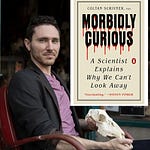Today Razib talks to Noah Millman. Millman is an American screenwriter and filmmaker, as well as a political columnist and cultural critic based in Brooklyn, New York. He is the film and theater critic for Modern Age; previously he was a columnist for The Week (2015–2022) and a senior editor at The American Conservative (2012–2017). Millman writes the newsletter Gideon’s Substack, and his work has also appeared in outlets such as The New York Times and Politico. He graduated from Yale University and initially worked on Wall Street for 16 years, starting in a hedge fund's mail room, before leaving after the financial crisis to pursue creative endeavors full-time. Millman has been a producer on seven films, and written three and directed three. His most recent film is Resentment, and he is working on a novel, Fables of a Jewish Century.
Razib and Millman begin their conversation discussing their history as bloggers who began writing early in the first decade of the century, in the wake of George W. Bush’s invasion of Iraq. Millman discusses his disillusionment with neoconservatism, and his evolution into a moderate, if heterodox, Democrat. They also discuss their positionality in a political commentary landscape that has radically shifted over the last twenty years, and what it’s like to be strongly partisan. They discuss how their views of religion have changed, especially in the wake of the New Atheist movement after 9/11 and the emergence of psychedelic spirituality in the 2020s. Millman articulates his views as a Jew whose own theological commitments are minimal, stating that he believes that the “Hindus are right about God” but John Calvin was probably right about humans.
In the second half of the discussion, they pivot to the arts, beginning with how film as a medium has developed over the last generation, from the high tide of independent films in 1999 and through the “comic book” movie heyday of the 2010s, and on finally to the reemergence of more classic movies like Tom Cruise’s Top Gun: Maverick 2 and Brad Pitt’s F1. Razib argues that the Marvel universe exhausted its creative possibilities, and the same content no longer compels the younger generations, especially in a 90-minute format. Millman addresses whether film as a medium has reached the end of the line as a mass medium, and how fan-culture and “stan” culture has transformed the experience of the arts. He also asserts that cultural fragmentation is driven by technology, as consumers have a much greater range of options in their choices than in the past. Millman observes that as top-down cultural dynamics have collapsed, shifts are now driven by bottom-up drives. He also argues that movies will continue to be a major art form because filmmaking is now far cheaper than it was in the past, but he is not optimistic about the future of mass-market tent-pole films that can transcend myriad fan subcultures. Movie studios still do not know which films will become hits and which will flop, even the magic of Pixar and Marvel Studios are no longer a sure thing. In fact, Millman argues that fragmentation has masked the revival of art forms like the novel. As the gatekeepers are gone, many consume low art, with middle-aged people reading copious amounts of YA fiction. Millman argues that any aspiring artist needs to grapple with the competitive realities of the new attention economy. Technology has made it easier for anyone to create art because new tools are cheaper and self-publishing is now a real option for writers. However, all of this unleashed creativity is competing for the same amount of funding, support and a relatively fixed audience.














